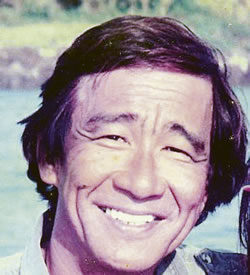Remembering A Hawaii TV Icon

Hari Kojima. Photo courtesy KHON2
Growing up on Kaua’i, there were several must-see television shows every weekend. It started Friday nights with Wrestling Hawaii. Then there were the classics, The Wild Wild West and Gunsmoke. On Sundays we watched Mutual of Omaha’s Wild Kingdom, which was followed by the main event of the weekend, Let’s Go Fishing.
“OK, gangee” were words we came to adore as the master fish cutter from Tamashiro Market went to work. Host Bruce Carter watched in amazement with the rest of us as Hari Kojima cleaned an ahi or aku with that boyish laid-back charm and big smile. He made everything look so easy.
I never imagined one day I would work in the same studio as this television icon. I still remember the first day I met Kojima at KHON2 at the old studio on Auahi Street. It was 1985. I was a young sports intern and Kojima was co-hosting Let’s Go Fishing. He walked into the news-room dressed in an aloha shirt, shorts and slippers and flashed that familiar grin, “You new here! I’m Hari!”
I was in awe, but he didn’t make a big deal of my staring. From that day on he made it a point to always say, “Howzit” and flashed me a shaka sign. He was the real deal.
“A lot of the things we consider and hold very important to our identity here in the islands, is still on TV because we’re all copying Hari and what he did,” says current Let’s Go Fishing host Ben Wong.
When Kojima took the reins from Carter, his popularity exploded. He co-hosted the show with photographer Stan Wright, who admits they were the odd couple back then.
“Hari always said I got the job because I could talk the most goodest,” laughs Wright. “When he was in front of a group he held the audience in his hand. Boy, he got in front of that TV camera and it was just magic. There may be other fish cutters out there who are better than he was, but I’ve never seen one.”
Wright says his longtime television partner’s knowledge of Hawaii’s ocean life was simply remarkable. “He could name every fish, the Hawaiian name, English name, Japanese name, even all the Latin names of all the fish. He definitely knew his fish.”
For many years, the show was one of the most popular programs on local television, thanks in large part to Kojima.
“As far as ratings were concerned, they ruled. They out-rated the news; it was the most popular program,” says Wong.
The laughs and good times continued for 29 years and along the way Kojima shared thousands of recipes, many of them from his mother.
“At the end of the show we had that ‘send in your self-addressed stamped envelope,’ and we’ll send you a copy of the recipe. If we didn’t get 400 or 500 requests per week, we’d think, ‘Wow, what happened, this must have been a really junk recipe,'” laughs Wright.
Kojima shared more recipes on the popular Hari’s Kitchen, which had a near 10-year run, and he was MidWeek‘s first food columnist in conjunction with that show.
His long relationship with KHON2 ended in 1998 but his popularity continued. In 2004, Leeward Community College awarded Kojima membership in its Culinary Hall of Fame. He often joked that if he ran for office, any office, he’d win. He was probably right. He was that popular, until the very end.
On Wednesday, June 8, Hari Kojima died at his home in Kaneohe surrounded by his family. He lost his monthlong battle with cancer at the age of 65.
“We had some really good times and many memories,” says Wright.
Aloha, Hari, and thank you for the good times and memories for all of us. You were a must-see for decades and you will be missed.
Kojima leaves behind a wife, four daughters and seven grandchildren. Services will be held July 16 at Mililani Mortuary. He’ll be buried the following Monday in a private service at the Hawaii State Veterans Cemetery.



